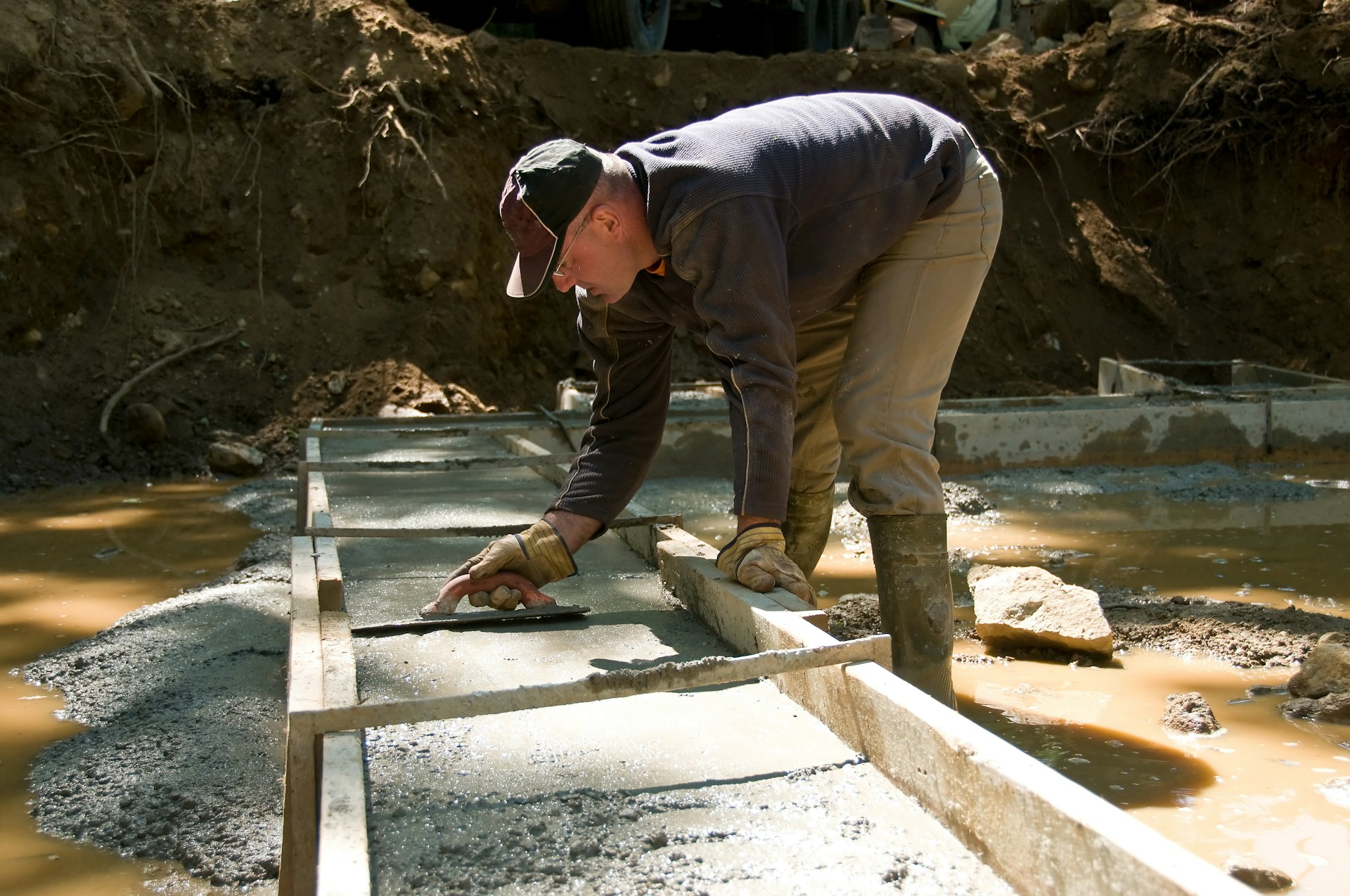Noticing cracks in your walls? Floors uneven? These could be signs that your concrete foundation needs attention. Repairing foundation damage early helps you avoid bigger issues, costly repairs, and long-term safety risks.
Concrete foundation repair isn’t one-size-fits-all. Sometimes, minor cracks can be patched up easily. But in many cases, problems like sinking slabs or stair-step cracks point to deeper structural issues that need expert care.
At Helicon, we believe in solving the root of the problem using methods that are designed to last. Whether it’s stabilizing weak soil, lifting concrete, or sealing critical cracks, we tailor every repair to your property’s specific needs.
In this blog, we will talk about:
- The warning signs that your concrete foundation needs repair
- Effective repair techniques used by professionals
- How to protect your foundation with ongoing maintenance
Let’s dive into what you should watch for and how to take the right action before minor damage turns major.
Understanding Concrete Foundation Repair
Concrete foundation repair involves fixing issues that affect your home’s stability. Knowing common problems, what causes them, and how to spot damage early can save you time and money.
Common Foundation Problems
Noticing unusual changes around your home? Your concrete foundation could be the cause. Here are the most common problems to watch out for:
- Cracks in concrete: Even small cracks can expand over time, leading to serious structural risks if not addressed early.
- Sinking or uneven slabs: Soil shifting or erosion underneath your home causes parts of the foundation to settle lower than others, leading to uneven floors and instability.
- Water damage: Excess moisture weakens concrete, encourages mold or mildew, and may cause wood rot inside your walls and floors.
- Door and window misalignment: Foundation movement often leads to doors and windows sticking or not closing properly.
- Gaps in interior walls or ceilings: As the foundation shifts, separation may appear between floors, ceilings, and walls.
Spotting these issues early can help you avoid larger structural damage and expensive repairs.
Causes of Concrete Foundation Damage
Wondering what’s really behind those foundation issues? It often starts beneath your feet, with the soil. Here are the most common causes to be aware of:
- Expanding or shrinking soil: Seasonal changes like rain and drought cause soil to expand or contract, putting uneven pressure on the foundation.
- Soil erosion or washout: Heavy rain can wash away supporting soil, leaving parts of the foundation unsupported and prone to sinking.
- Poor drainage systems: Water pooling near your home increases soil moisture, weakening the ground and stressing the concrete.
- Plumbing leaks beneath the slab: Hidden leaks add moisture to the soil, which can lead to soft spots or shifting.
- Weak or poorly compacted soil: If the soil wasn’t packed properly during construction, it can settle unevenly and cause structural issues.
- Tree roots under the foundation: Roots can push against or displace soil beneath your home, leading to cracks and movement.
- Natural settling over time: All homes settle slightly, but excessive movement signals deeper foundation concerns.
- Florida-specific conditions: In areas with weak soils or sinkholes, like much of Florida, foundation damage requires specialized solutions from experts like Helicon.
Understanding these causes is the first step toward choosing the right repair method and keeping your foundation strong for years to come.
Signs Your Foundation Needs Repair
Look for these warning signs around your home to catch foundation problems early:
- Cracks in walls, floors, or concrete slabs, especially stair-step cracks in brickwork
- Doors and windows that stick or don’t close properly
- Uneven or sloping floors
- Gaps between walls and ceilings, or floors
- Water pooling near the foundation after rain
If you spot any of these signs, it’s best to get a professional inspection right away. A timely assessment prevents small problems from turning into major repairs.
Assessment and Inspection Process
Understanding the condition of your concrete foundation starts with a thorough inspection. This process involves evaluating damage, using specific tools, and determining the repairs’ urgency.
Professional Foundation Evaluation
A professional foundation evaluation begins with a detailed visual inspection.
An expert examines both inside and outside your home, checking for visible cracks, uneven floors, doors or windows that stick, and gaps around frames. The inspector also reviews your home’s history and soil conditions. Shifting soil or poor drainage can cause damage.
A trusted service like Helicon provides this thorough evaluation, combining experience with knowledge of local soil issues. You’ll receive a clear report highlighting concerns and a recommended plan to keep your foundation stable.
Tools and Methods for Inspection
Inspectors use several tools and techniques to get precise data.
- A level and laser measuring devices check for uneven floors or sloping.
- Crack gauges measure the width and changes in cracks over time.
- More advanced equipment, like ground-penetrating radar, helps detect underground voids and soil movement that aren’t visible.
- Moisture sensors identify water damage or drainage problems in the foundation.
Together, these methods provide a full picture of your concrete’s health.
Identifying Severity of Damage
Not all foundation issues need the same repair approach.
Once damage is found, its severity is classified by type and extent. Minor cracks may only require monitoring or sealing to prevent water entry. More serious problems include stair-step cracks, significant foundation movement, or sinking slabs.
These indicate structural instability and need immediate repair to avoid costly future damage. The level of damage detected during inspection determines the repair plan. Helicon uses this assessment to recommend permanent solutions tailored to your home’s specific needs.
Concrete Foundation Repair Methods
Repairing your concrete foundation involves several proven methods designed to address common issues like settling, cracks, and shifting. Each approach targets specific problems to restore stability and prevent further damage.
Slab Jacking and Mudjacking
Slab jacking, also called mudjacking, raises sunken concrete slabs by injecting a slurry mix underneath. This method is often used for driveways, sidewalks, and patios, but can also be applied to certain foundation slabs.
The process fills voids beneath the slab, lifting it back to its original level. It is cost-effective and less invasive than full replacement. However, it works best for minor settling and may not be suitable for severe foundation failure. Slab jacking helps stop water pooling and uneven surfaces, extending the life of your concrete.
It’s important to have a professional evaluate your foundation to see if this method fits your needs.
Piering and Underpinning
Piering stabilizes foundations that have settled too deeply by placing steel or concrete supports, called piers, beneath the footing.
Underpinning is a similar method used to reinforce existing foundations by extending support to stable soil below. This technique is ideal for serious foundation shifts, especially in Florida’s soft or shifting soils. Installation involves drilling beneath the foundation and securing piers to solid ground.
Piering can stop sinking floors and cracked walls by redistributing the building’s weight. When done by experts like Helicon, it offers a durable solution that can last decades with minimal maintenance.
Epoxy Injection
Epoxy injection is a precise repair method for sealing cracks in concrete foundations.
After cleaning the crack, epoxy resin is injected to bond and seal it. This repair restores structural integrity and prevents water infiltration, which can lead to further damage. Epoxy injection is suitable for narrow, non-moving cracks and is often part of early foundation maintenance.
While effective, epoxy does not address underlying soil issues or major settling. You’ll want a qualified pro to inspect and decide if this method will work for your foundation problem.
Sealant and Crack Repair Techniques
Applying sealants and patching compounds can protect your foundation from minor cracks and surface damage.
Start by cleaning cracks and removing loose debris. Fill holes and cracks with hydraulic cement or a specialized patching compound. Allow the repair material to cure fully before sealing with a waterproof coating.
This simple approach helps prevent moisture entry and slows deterioration, but is generally a temporary fix. It works best when combined with regular inspections and prompt action on emerging foundation issues.
Choosing the Right Repair Technique
Picking the right method to fix your concrete foundation depends on specific conditions around your home. The technique must address the cause of damage, suit your budget, and provide a long-lasting solution.
Factors Influencing Repair Method
Not every foundation issue can be solved the same way. Here’s what professionals consider when choosing the most effective repair technique for your home:
- Foundation type: Slab, crawl space, or basement foundations respond differently to soil movement and require tailored repair strategies.
- Severity of damage: Minor cracks may only need sealing, while severe settling or shifting demands structural solutions like piers or underpinning.
- Soil conditions: Clay, sand, or loosely compacted soils behave differently under pressure. Some may need stabilization before repairs can even begin.
- Moisture exposure: Foundations with prolonged water damage often require drainage correction or deeper soil repairs in addition to surface fixes.
- Location of the problem: Cracks in load-bearing areas require more structural reinforcement than cosmetic damage on a patio or walkway.
- Concrete strength requirements: Choosing the right PSI-rated concrete mix is essential for durability and load-bearing performance.
- Environmental conditions: In areas like Florida, sinkholes or soft ground demand specialized methods like pressure grouting or deep pier installation.
These factors are why a professional evaluation is so important. Helicon uses them to create a repair plan that actually lasts, not just a temporary patch.
Cost Considerations
Repair costs vary widely based on the technique, damage severity, and materials used.
Concrete piers usually cost more due to excavation and materials, but offer long-term stability. Slabjacking and polyurethane foam injections tend to be less expensive and less invasive, suitable for minor settling issues. You should consider lifetime costs, not just the upfront price.
A cheaper repair might need redoing sooner, increasing overall expenses. Soil conditions can also raise costs if additional soil stabilization is needed before foundation work. Helicon works with you to find cost-efficient solutions without compromising quality.
Getting a detailed estimate upfront helps you plan financially and avoid surprises during the project.
| Repair Method | Typical Cost Range | Ideal Use Case |
|---|---|---|
| Concrete Piers | High | Major foundational support |
| Slabjacking | Moderate to Low | Mild settling; minimal damage |
| Polyurethane Foam | Low to Moderate | Quick lift; non-invasive slabs |
| Soil Stabilization | Varies | Weak or shifting soils |
Knowing these points helps you choose a repair method that fits your home’s condition and your budget.
DIY vs. Professional Repair
When fixing concrete foundation issues, the choice between doing it yourself and hiring a professional can affect the safety and long-term stability of your home. Knowing the risks and benefits can help you decide which path is best for your situation.
DIY Concrete Foundation Repair Risks
Thinking about fixing foundation cracks yourself? It might look simple, but there’s more beneath the surface. Here are the real risks that come with DIY foundation repair:
- Using the wrong tools or materials: Most DIY kits aren’t suited for structural repairs and may not bond or seal properly over time.
- Missing deeper structural problems: Surface cracks can hide larger issues like slab movement or soil erosion that only pros can detect.
- Lack of proper equipment: It’s hard to assess or correct foundation settling accurately without tools like hydraulic jacks or pressure meters.
- Making incomplete or temporary fixes: DIY solutions often cover symptoms but don’t address the root cause, allowing damage to continue quietly.
- Not monitoring crack progression: Small cracks may grow if not watched carefully, and DIYers often skip long-term tracking.
- Creating new safety hazards: Incorrect repairs may compromise the structure, putting your home at greater risk during storms or over time.
- Costing more in the long run: What starts as a budget fix can lead to costly professional rework if the problem gets worse.
When it comes to your home’s foundation, it’s worth getting expert eyes on the issue before picking up a patch kit.
Benefits of Hiring a Foundation Repair Specialist
A professional team like Helicon brings experience and tools designed for permanent foundation repair. Specialists can identify the root cause of damage and provide custom solutions, such as helical piers or soil stabilization methods.
Hiring experts means you get thorough inspections, accurate diagnostics, and work done to code. This approach lowers the risk of future repairs and helps maintain your home’s value.
Professionals handle complex problems safely and efficiently. They also offer ongoing support and communication, so you’re informed throughout the process.
Preventing Future Foundation Issues
Preventing foundation problems starts with managing water around your home and stabilizing the soil beneath it. These factors directly impact how strong and steady your foundation remains.
Water Management and Drainage Solutions
Water is one of the leading causes of foundation damage. To keep water away from your foundation, you should ensure proper drainage around your home.
Key steps include:
- Installing gutters and downspouts to channel rainwater away from the foundation.
- Grading the land so it slopes away from your house, preventing pooling near walls.
- Using French drains or similar systems to redirect groundwater.
Check these features regularly for blockages or damage to maintain effective water flow. Preventing excess moisture reduces the risk of cracks and settling.
Soil Stabilization Methods
The soil under your foundation affects how much your home shifts or settles. In places like Florida, weak or loose soils can cause uneven foundation movement.
Options to strengthen soil include:
- Helical piers: Steel shafts driven deep into stable soil to support your foundation.
- Compaction grouting: Injecting grout to fill voids and increase soil density.
- Chemical stabilization: Treating soil with special materials to improve strength.
These solutions improve long-term foundation stability by preventing soil erosion and sinkholes. Helicon specializes in these methods, giving you safer, more secure results.
Long-Term Maintenance of Concrete Foundations
Maintaining your concrete foundation over time requires routine care and early attention to small issues. Consistent checks and quick repairs can prevent bigger problems and keep your home stable.
Regular Inspection Schedule
You should inspect your foundation at least twice yearly, ideally in spring and fall. Look for signs like minor cracks, uneven floors, or gaps around doors and windows. These often point to early foundation movement.
Use a checklist to track your observations:
- Visible cracks or chips
- Moisture buildup near the foundation
- Shifts in basement walls or crawl spaces
If you notice anything unusual, act quickly to avoid damage. Scheduling professional inspections every few years ensures a thorough assessment. Experts can spot hidden problems that are easy to miss.
Addressing Minor Cracks Early
Small cracks in your foundation are common but should never be ignored. These can let moisture in, which may worsen the damage over time. Early repairs stop cracks from growing and causing structural issues.
To handle minor cracks:
- Clean the crack and remove loose debris
- Use an epoxy or polyurethane sealant to fill the crack
- Monitor repaired areas for any changes
If cracks widen or multiply, contact experts like Helicon for a deeper evaluation.
Wrapping It Up
Your home’s foundation does more than hold up walls, it protects everything inside.
Ignoring small cracks or signs of sinking can lead to serious damage and expensive repairs. But with the right knowledge and expert support, you can take action early and protect your investment long-term.
At Helicon, we don’t believe in temporary fixes. We offer permanent, proven solutions tailored to your soil, structure, and budget. Whether it’s lifting sunken slabs or reinforcing unstable ground, our team is here to help.
Schedule your free foundation inspection today and let Helicon show you exactly what’s happening under your home, and how we can fix it before it gets worse.
Frequently Asked Questions
Still have questions about concrete foundation repairs? You’re not the only one. Many homeowners aren’t sure when a crack is serious or what happens after the repairs. These quick answers will help clear up the uncertainty and guide your next steps.
How can I tell if a foundation crack is structural or cosmetic?
Structural cracks are typically wider than a quarter inch, run at angles, or appear in a stair-step pattern. Cosmetic cracks are hairline and don’t spread over time. If you’re unsure, it’s best to get a professional inspection.
Can heavy rain cause immediate foundation problems?
Yes, especially if your drainage is poor. Heavy rain can saturate soil quickly, leading to erosion or shifting beneath your foundation. Sudden pooling near the base of your home after a storm is a sign you should investigate further.
Is it safe to live in a home while foundation repairs are being done?
In most cases, yes. Many foundation repairs, like pier installation or foam injection, are non-invasive and allow you to stay in the home. Your contractor will advise if any short-term relocation is needed for safety.
Do foundation issues affect property resale value?
They can. Unresolved foundation damage may lower your home’s value or scare off buyers. On the flip side, professionally repaired foundations with warranties can improve buyer confidence and make your home more marketable.
What maintenance should I do after a foundation repair?
Maintain proper drainage around your home, monitor any repaired cracks for movement, and schedule a professional check-up every few years. Avoid planting large trees too close, and watch for new signs of settling or shifting.





